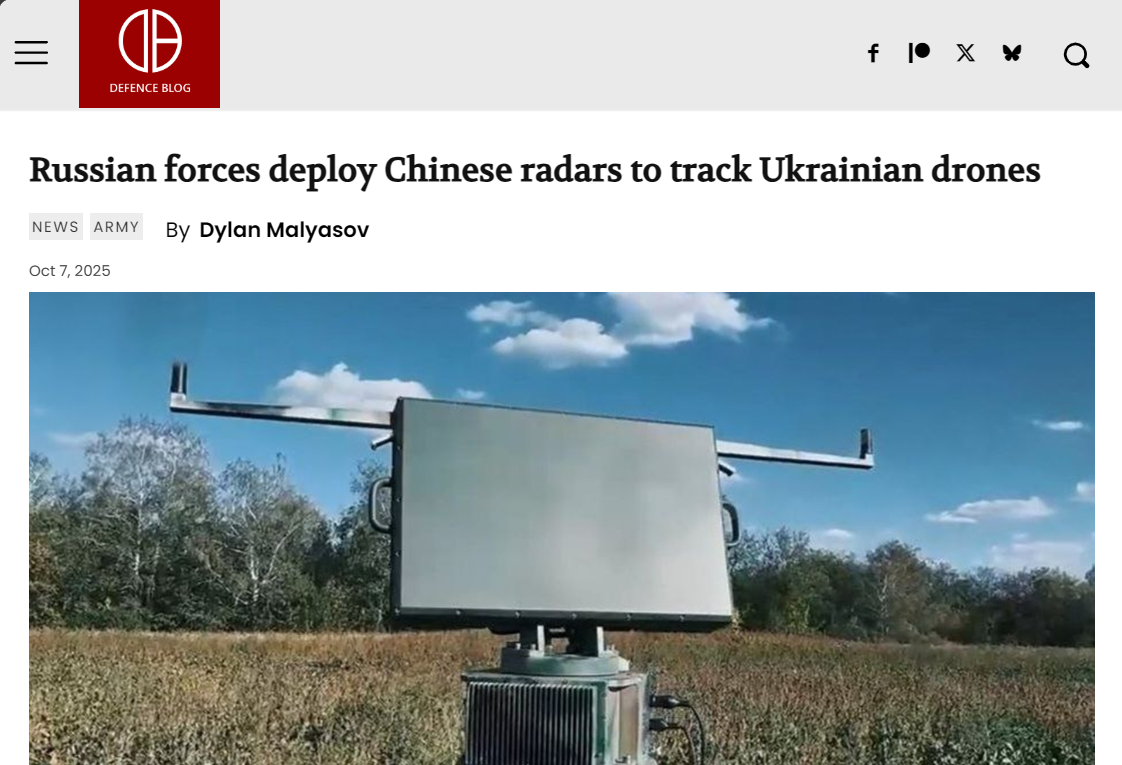Background: Reports of Chinese Civilian Radars in Russian Air Defense
Several international outlets — including Defence Blog and Kan China — recently reported that Russian air-defense units have been seen using Chinese-made civilian radar systems such as the FSTH-LD02 and FSTH-LD03 to track Ukrainian drones.
These radars, designed for civilian low-altitude monitoring and airport security, reportedly offer detection ranges of 10–15 km, capable of spotting small targets with radar cross-sections around 0.01 m². While not military-grade systems, they appear to have been integrated into makeshift anti-drone networks on the battlefield.
Experts quoted in Sina Finance and 6Park News note that these devices were never designed or certified for combat — lacking hardened communication, encryption, or electromagnetic protection. Their use thus raises dual-use and export compliance concerns, rather than any direct evidence of Chinese military sales.
Civil vs. Military Radar: A Technical Boundary
| Aspect | Civilian Radar | Military Air-Defense Radar |
|---|---|---|
| Intended Use | Airspace management, drone monitoring, safety systems | Target acquisition, missile guidance, countermeasures |
| Detection Range | 5–20 km | 50–300 km |
| Anti-Jamming Capability | Medium (software-based) | Very High (frequency agility, ECCM) |
| Communication Protocol | Open, API-based | Encrypted, classified |
| Deployment | Modular and portable | Fixed or vehicle-mounted systems |
Even if hardware sensors are similar, the system architecture, software stack, and reliability requirements are vastly different.
In other words: civilian radars cannot simply be repurposed into military-grade systems without extensive redesign.
Lakeda’s Role and Technical Position
Wuhan Lakeda Radar Systems Co., Ltd. (branded as Lakeda Radar Systems) has long specialized in low-altitude security and counter-UAV radar technologies, designed exclusively for civilian and protective applications.
Our Core Technical Advantages
- High-Sensitivity Detection – Doppler and micro-motion analysis to identify small, slow targets.
- Hybrid Scanning Architecture – Combining mechanical rotation with phased scanning for full azimuth coverage.
- Open API Integration – Compatible with optical systems, C2 platforms, and public safety monitoring networks.
- Portable & Modular Deployment – Rapid setup for airports, ports, and urban airspace monitoring.
- Multi-Sensor Fusion – Seamless cooperation with EO/IR, AIS, ADS-B, and RF detection systems.
Our systems serve airports, coastal monitoring, energy infrastructure, and smart cities — not military operations.
Official Statement from Lakeda Radar Systems
In response to the recent news coverage, Lakeda issues the following official position:
1. We firmly oppose any military use of our equipment
Lakeda has never authorized, endorsed, or participated in any deployment of its radar systems for warfare or combat applications.
Any such use violates our ethical and contractual principles.
2. We maintain strict export compliance and end-user verification
All exports comply fully with Chinese regulations and international treaties.
We perform multi-level due diligence and require customers to declare the civilian nature of use.
3. Traceable and transparent technology
Every unit is equipped with a unique software serial number and license verification system, enabling tracking of ownership and deployment.
We reserve the right to terminate service or legal support if misuse is detected.
4. Commitment to peace and civilian innovation
Lakeda’s mission is to protect people, not participate in conflict.
We advocate for radar technology to serve public safety, airspace management, and environmental protection, never warfare.
Looking Forward: Technology Serving Peace
The incident highlights the global challenge of dual-use technology — how civilian innovations can be distorted by conflict.
Lakeda believes that responsibility begins with the manufacturer.
Our future commitments include:
- Stronger export transparency and usage monitoring
- Integration of time-limited licenses to prevent reactivation in prohibited contexts
- Collaboration with international regulatory bodies on civilian radar standards
- Development of small radar networks for cooperative low-altitude safety
- Continuous public disclosure of compliance efforts
Conclusion
Technology itself is neutral — but its use defines its moral value.
At Lakeda, we believe radar should see, not strike.
We remain committed to building systems that protect skies, ports, and people, never to endanger them.
“The true power of technology lies not in destruction, but in protection.”
— Lakeda Radar, Oct 2025
References
- Defence Blog – Russian Forces Deploy Chinese Radars to Track Ukrainian Drones
- Kan China – Reports on Civilian Radar Use
- Sina Finance – Civil Radar Controversy Analysis
- 6Park News – Observations on Dual-Use Radar
